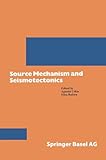Source mechanism and seismotectonics Libro electrónico edited by Agustín Udías, Elisa Buforn
Tipo de material: Libro
en línea Idioma: Inglés Detalles de publicación: Boston, Massachusetts, United States Birkhauser Verlag c1991Descripción: v, 576 páginas ilustraciones mapas 24 centímetrosISBN:
Libro
en línea Idioma: Inglés Detalles de publicación: Boston, Massachusetts, United States Birkhauser Verlag c1991Descripción: v, 576 páginas ilustraciones mapas 24 centímetrosISBN: - 376432709X
- 081762709X
- 9783034897181 (Print)
- 9783034886543 (Online)
- Disponible en línea
Incluye bibliografía
1. Introduction.. 2. Intermediate and deep earthquakes in Spain.. 3. Spanish national strong motion network. Recording of the Huelva earthquake of 20 December, 1989.. 4. Regional focal mechanisms for earthquakes in the Aegean area.. 5. Rates of crustal deformation in the north Aegean trough-north Anatolian fault deduced from seismicity.. 6. Regional stresses along the eurasia-africa plate boundary derived from focal mechanisms of large earthquakes.. 7. Focal mechanisms of intraplate earthquakes in Bolivia, south America.. 8. Partial breaking of a mature seismic gap: the 1987 earthquakes in new Britain.. 9. Size of earthquakes in southern Mexico from indirect methods.. 10. Numerical simulation of the earthquake generation process.. 11. Intermagnitude relationships and asperity statistics.. 12. Complete synthetic seismograms for high-frequency multimode SH-waves.. 13. Body-wave dispersion: measurement and interpretation.. Bibliography
Disponible para usuarios de ECOSUR con su clave de acceso
Nesus, Armenia, and Georgia have largely profited from the experience acquired in the study of the large events of the early 1980s. The Mediterranean region is not only the site of shallow dispersed seismic activity, it is also the site of localized intermediate depth seismic activity, and of some rare deeper events. Active subduc tion is clearly at the origin of Greek intermediate depth seismicity, while the deep activity under Calabria and the Vrancea region in Romania is clearly related to downgoing slabs that have long remained active after the arrest of subduction. The origin of the intermediate and very deep seismicity below Spain is a considerably more complex problem. Several possible explanations of the intermediate depth activity to about 110 km have been proposed, but the origin of the deep (650 km) events studied by BURFORN et a1. remains a mystery since this is the only source of deep activity that is not related in an obvious way to a subduction zone. The problem of seismic source mechanism and seismotectonics cannot be completely separated from that of the mechanical origin of earthquakes. Recent work on this subject has revealed the intimate relation between fault geometry, as observed by field geologists, and the results of inversion of source process from seismic data in the far-field or in the near-field. Inglés
Disponible en línea
Disponible en formato PDF


